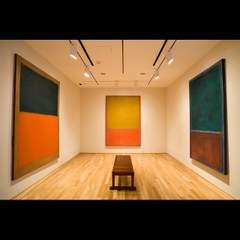|
Back
Ladders to Elysium New York
Christ and St.Stephen’s Episcopal Church
03/28/2014 -
Journeys in Silence, Part II
Erik Satie: Four Ogives
Haskell Small: The Rothko Room: Journeys in Silence
Alan Hovhaness: Sonata for Piano “Prospect Hill”, Opus 346 – Sonata for Piano “Mt. Katahdin”, Opus 405: Lullaby – Macedonian Mountain Dance, Opus 144 – Pastoral No. 1, Opus 111, No. 1 – Sonata for Piano “Mt. Chocorua”, Opus 335: “Hymn to Mt. Chocorua”
Haskell Small (Pianist) 
H. Small (© Coco T. Dog)
These last two days have brought fourth five attempts at ecstasy. The New York Philharmonic produced Anton Bruckner’s religious ecstasy, his attempts to glorify the stolid Heavenly Father, complete with harps and horn calls. On the same program, Claude Vivier produced a work of unalloyed sexual ecstasy, an experience where all the senses must participate in this most sensual of all worlds.
Last night, Haskell Small, the Chair of the Piano Department of the Washington Conservatory of Music, and a major recording artist, offered three composers, including himself, all of whom have eschewed “abstract” music, attempting to to portray an Ecstatic Something which is outside music itself.
(The venue of a church might have been the ideal setting, except that the pews of the Christ and St. Stephen’s Episcopal Church creaked and squeaked like church mice with the slightest movement of the audience.)
Sections, notably from Alan Hovhaness, were highly successful. Other parts didn’t quite make it. But with a pianist of Mr. Small’s immaculate playing and obvious appreciation of the evening’s theme, one had an inkling, a scintilla of eternity.
The opening Four Ogives was an early Satie work which was not the satirical surrealistic compositions we all know. Rather, the work, based on church architecture was plainly religious. He would continue this structure (a chant followed by simple chordal repetitions) in his Rosicrucian music, and his equally mystical music in his Socrate. In the meantime, Mr. Small introduced the concert with fitting solemnity.
The second half of the program consisted of five piano works by Alan Hovhaness–and I couldn’t have been more surprised. Yes, this is music which reaches for the stars (or at least his Sacred Mountains), but Mr. Hovhaness, amidst his 450-odd opuses included some musical effects resembling composers like Henry Cowell.
Specifically, the Pastorale, written in 1952, where the inner strings of the piano were played, a microphone bringing out the whooshing atmosphere. His other works were reminiscent of the Satie Eternal Philosophy–the medieval harmonies, the chants, the extraordinarily sad Lullaby The difficult Macedonian Dance, which I only know in the orchestral version, was given in piano terms here.
In fact, Hovhaness is such a colorful orchestrator, I never realized he had written so much piano music. Mr. Small did, and his lovely touch made the works sing.

Rothko Room(© Lautmann/www.phillipscollection.org)
The centerpiece of the concert, though, was Haskell Small’s own work, The Rothko Room: Journeys in Silence. It was premiered in the very room where Mark Rothko had arranged four of his works in the Phillips Collection. Four movements for four paintings. (And presumably, as Rothko asked that only a single bench be place in the room, we, the audience, would be that bench.
Strangely, it didn’t “sound” like Rothko at all. Perhaps because, by definition, music moves and paintings are static. Once you write down two notes, you immediately say goodbye to the very idea of paintings and go into your own media.
Music may decorate paintings. In the Granada Museum, I once saw Impressionist Spanish paintings with a background of Falla’s Nights in the Gardens of Spain, written in Granada itself, and that was perfect. Or it may give a musical impression as in Martinù’s Frescoes or Mussorgsky’s Pictures.
But to offer a simulacrum is probably aesthetically impossible.
Morton Feldman, himself a composer of near-static music, spent his entire all-too-short career trying to capture the very stillness of contemporary art, and probably succeeded more than others. In fact, his own Rothko music, Rothko Chapel, is perhaps the sheerly most emotionally beautiful work he ever wrote. It was composed after Rothko’s suicide, so it includes singers, as well as a single dark viola, celesta and percussion. If it sounds like a requiem, so be it. Yet I am listening to it now, and the sounds can, with imagination, be Rothko-like. The music, passed from one block to another, slowly, inevitably, darkly deeply, are as moving as anything he ever wrote.
Haskell Small took a more literal approach in his four sections. Almost all treble bells (to show Rothko’s “mysticism”), more swirling piano music, including some near chorales (“the angelic sweep”, “multiple lights” presaging “his eventual suicide”) and a delightful Chopinesque polonaise in the last movement, as “a last burst of creativity”. Then, then the return to silence.
I liked the work by itself, but had no particular feeling about Mark Rothko. The bells and the Polonaise could have come close to Marc Chagall, but Rothko painted abstractions, and attempting to embody his blocks with very moving chords and harmonies is a distraction more than a simulation.
For the encore, Mr. Small went back to music which resounded with the simple harmonies and mystical longings of Satie and Hovhaness. Arvo Pärt’s lovely work, which I believe was Für Alina.
We never knew saw the object, we heard only the music. Mr. Small, with his impeccable technique and feeling, was the ideal pianist. For these notes were the ideal pathways to reach a personal heaven with a mere 88 keys.
Harry Rolnick
|